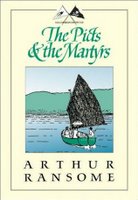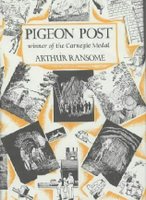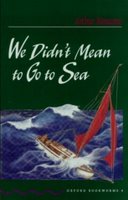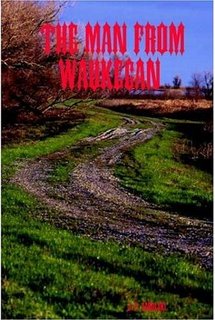I’ve just finished reading the Swallows & Amazons series, by Arthur Ransome. Most of them, that is – my copy of one book seems to have gone into hiding, so I had to skip it. This has been one of my favourite series since I first discovered it (eighth grade, as I recall), and since this is my blog and I can write about anything I want, I’m going to write about this.
The series consists of twelve books, written in the 1930s and ’40s, about English children and
sailboats. (A thirteenth book was started but never finished.) Most of the books are set in either the Lake District (on and around a nameless, fictional lake which combines elements of
Windermere and
Coniston Water) or the Norfolk
Broads (using real geography).
The Swallows are the four Walker children: John, Susan, Titty
* and Roger. Their father is an officer in the Royal Navy and is seldom seen in the books, but their mother and their younger sister Bridget appear often. The Amazons are the Blackett sisters, Nancy and Peggy, a pair of tomboys who are growing up on the shores of the lake. (Nancy’s name is actually Ruth, but the girls play at being Amazon pirates, and their Uncle Jim has told them that real pirates are ruthless, so....) The only time a definite age is given for any of them is in the first book, when Roger is seven, but going by Ransome’s notes for another book the starting ages of the others are nine (Titty), eleven (Susan and Peggy) and twelve (John and Nancy, the latter being slightly older).
Two other sets of children, the Ds and the Coots, are also important in the series. The Ds – Dick and Dorothea Callum – are the children of an archaeologist; Dot is a budding novelist, while Dick is interested in all aspects of science. They’re somewhere around Titty’s age, with Dorothea being the older of the two. The Coots, who all live in the village of Horning, in the Broads, are Tom Dudgeon, a doctor’s son; twins Bess and Nell Farland (commonly known as “Port” and “Starboard”); and the three Death and Glories, Bill, Joe and Pete. (Like the Swallows and the Amazons, the latter get their group name from the name of their boat.) No ages are given for the Coots, either, but Tom is a little older than the Ds, the twins are about their age, and the other three are a little younger.
 Swallows and Amazons
Swallows and Amazons (
SA) takes place during the summer holidays of 1930. The Walkers (with the exception of Daddy, whose ship is in Malta) are spending the summer holidays at Holly Howe farm, by the lake. The children have been using the farm’s sailing dinghy,
Swallow, to explore, and have requested permission to camp on a nearby island. Mother has passed the buck to Daddy, and the book starts with the children waiting for a reply to the letters they have written. The reply comes in the form of a telegram: BETTER DROWNED THAN DUFFERS IF NOT DUFFERS WON’T DROWN. Hurray! Plans are completed, stores and equipment are assembled, and the four of them are off to the island. The Blacketts, who also have a sailboat (
Amazon), have been using the island as a campground for some time, however; the two groups agree to fight a war, with the winners being the ones who first capture the other boat. The Amazons’ Uncle Jim has been holed up in his houseboat (complete with parrot and cannon) all summer, writing a book, refusing to join in the girls’ games, and being no fun whatsoever, and so plans are made to declare war against him, too. But now he seems to have gotten the idea that the Swallows have been mucking with his boat - and then the boat is burglarised and his book is stolen....
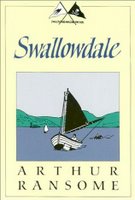 Swallowdale
Swallowdale (
SD) takes place the following summer. The Swallows have returned to the lake, and Uncle Jim (dubbed “Captain Flint” by Titty because of his parrot and cannon) is no longer tied up with writing, but the expected fun isn’t happening; the Blacketts’ Great Aunt Maria is visiting. The GA is a very strict, old-fashioned lady who expects Nancy and Peggy – excuse me, I mean Ruth and Margaret – to wear white frocks instead of shorts and shirts, learn poetry and recite it to her, practice the piano, and never be late for meals. Since Mrs Blackett and Uncle Jim were raised by the GA, they’re too much in awe of her to stand up to her. Until she leaves, the Swallows will be by themselves except when Nancy and Peggy can slip away. And then disaster strikes:
Swallow runs into a submerged rock and sinks. Her crew manages to salvage her, but until repairs are completed they won’t be able to sail, or to camp on the island. Fortunately, there’s a valley up on the fells above the lake that makes a good campsite, so the Swallows settle in for a different kind of adventuring - including mountain climbing, with the
mountain near Beckfoot (the Blackett home) standing in for Kanchenjunga.
 Peter Duck
Peter Duck (
PD) is metafiction, a fictional story “written” by people who are themselves fictional characters. In this case, the writers are the Swallows and the Amazons, who spent the winter holidays between
SA and
SD on a
wherry on the Broads, with Captain Flint. One of the ways they spent their time was in making up this tale of adventure, in which they sail in search of buried treasure. The story begins in Lowestoft harbour, where Captain Flint and the Amazons are readying their new schooner,
Wildcat (named after their island back at the lake), for sea. The Swallows arrive soon, but so does bad news – the man who was going to help Captain Flint work the ship isn’t going to be able to come. This severely limits what they can do, because while the children have plenty of experience with their sailboats, a ship this large is something totally new to them. Fortunately, an old seaman named Peter Duck has been admiring
Wildcat, and he offers to take the missing man’s place. But with Mr Duck comes trouble, for many years ago, when he was a young boy, he was shipwrecked in the Caribbean, and before he was rescued he saw two men burying something beneath a tree. He has no idea what it was they buried, of course, but the tale has grown in the telling and now many people believe it was treasure. And Black Jake, skipper of the
Viper, thinks that Peter Duck is taking the crew of the Wildcat to retrieve that treasure....
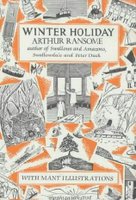 Winter Holiday
Winter Holiday (
WH) takes place a few months after
SD, during the winter of ’31-’32. Professor and Mrs Callum are in Egypt “digging up remains,” so Dick and Dorothea are spending the holidays at the Dixons’ farm (Mrs Dixon was Mrs Callum’s nurse when she was a girl), just down the road from Holly Howe. Late-evening astronomy leads to signaling to “Mars,” which in turn brings the Ds together with the Swallows and the Amazons. The plans this time are for an expedition to the North Pole, a place near the north end of the lake known only to Nancy and Peggy. Sledges are in daily use, an igloo is being built, and Captain Flint’s houseboat, which is frozen in, is doing duty as
Nansen’s
Fram. (Captain Flint is abroad for the winter.) All that’s really needed is a good, solid freeze before the end of the holidays, and they’ll be set. And then Nancy comes down with mumps, forcing her – and the others – into quarantine....
To be continued.
* Try giving a girl a name like that in a modern book! The four Walkers were based on children Ransome knew; the real Titty was given her nickname as a small child because her favourite book was something called Titty Mouse and Tatty Mouse.
 Dinosaurs Life Size was written by Darren Naish, author of the Tetrapod Zoology blog. As the title implies, it's meant to give an idea as to just how large those critters were. Obviously, most of them are too big to fit into a children's book, but....
Dinosaurs Life Size was written by Darren Naish, author of the Tetrapod Zoology blog. As the title implies, it's meant to give an idea as to just how large those critters were. Obviously, most of them are too big to fit into a children's book, but.... Nonfiction Monday is hosted this week by Sherrie, at Write About Now.
Nonfiction Monday is hosted this week by Sherrie, at Write About Now.













